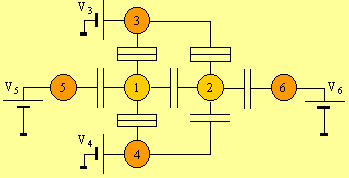Negative differential resistance device


This device displays negative differential resistance. The current increases at low bias voltages, then decreases for higher bias voltages, finally increasing again for even higher bias voltages. Amplifiers, logic, and memory elements can be constructed from devices that display negative differential resistance. To attain negative differential resistance, the gate voltages V5 and V6 are tuned so that the Coulomb blockade is supressed for electrons tunneling through island 1 while there exists a Coulomb blockade for electrons to tunnel onto island 2. As the bias voltage is increased, the threshold for an electron to tunnel onto island 2 is eventually reached and an electron tunnels onto island 2. If the coupling capacitor C12 is large, the tunneling of an electron onto island 2 makes a in the polarization charge of island 1 of about e/2. This puts island 1 in a Coulomb blockade region and the current through island 1 decreases.
C. P. Heij, D. C. Dixon, P. Hadley, J. E. Mooij, Negative differential resistance due to single-electron switching Applied Physics Letters, 74 p. 1042 (1999). cond-mat/9809272